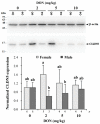Chronic Exposure to the Fusarium Mycotoxin Deoxynivalenol: Impact on Performance, Immune Organ, and Intestinal Integrity of Slow-Growing Chickens
- PMID: 29053594
- PMCID: PMC5666380
- DOI: 10.3390/toxins9100334
Chronic Exposure to the Fusarium Mycotoxin Deoxynivalenol: Impact on Performance, Immune Organ, and Intestinal Integrity of Slow-Growing Chickens
Abstract
This study investigates the long-term effects of deoxynivalenol (DON) consumption on avian growth performance, on the proliferation, apoptosis, and DNA damage of spleen cells, and on intestinal integrity. Two hundred and eight 5-day-old black-feathered Taiwan country chickens were fed diets containing 0, 2, 5, and 10 mg/kg of DON for 16 weeks. Body weight gain of male birds in the 2 mg/kg group was significantly lower than that in the 5 mg/kg group. At the end of trial, feeding DON-contaminated diets of 5 mg/kg resulted in heavier spleens. Moreover, the increase in DON induced cellular proliferation, apoptosis, and DNA damage signals in the spleen, the exception being female birds fed 10 mg/kg of DON showing reduced proliferation. Expression of claudin-5 was increased in jejunum of female birds fed 2 and 5 mg/kg of DON, whereas decreased expression levels were found in male birds. In conclusion, our results verified that DON may cause a disturbance to the immune system and alter the intestinal barrier in Taiwan country chickens, and may also lead to discrepancies in growth performances in a dose- and sex-dependent manner.
Keywords: chicken; deoxynivalenol; immunohistochemistry; intestine; long-term effects; spleen; tight junction.
Conflict of interest statement
The authors declare no conflict of interest.
Figures






References
-
- Canady R., Coker R., Egan S., Krska R., Kuiper-Goodman T., Olsen M., Pestka J., Resnik S., Schlatter J. WHO Food Additives Series. World Health Organization (WHO); Geneva, Switzerland: 2001. Deoxynivalenol. Safety evaluation of certain mycotoxins in food. Joint Expert Committee on Food Additives (JECFA) pp. 419–555.
-
- BIOMIN Holding GmbH 2016 BIOMIN Mycotoxin Survey Report. [(accessed on 29 September 2017)]; Available online: http://www.biomin.net/en/press-releases/latest-biomin-mycotoxin-survey-r....
MeSH terms
Substances
LinkOut - more resources
Full Text Sources
Other Literature Sources
Medical

